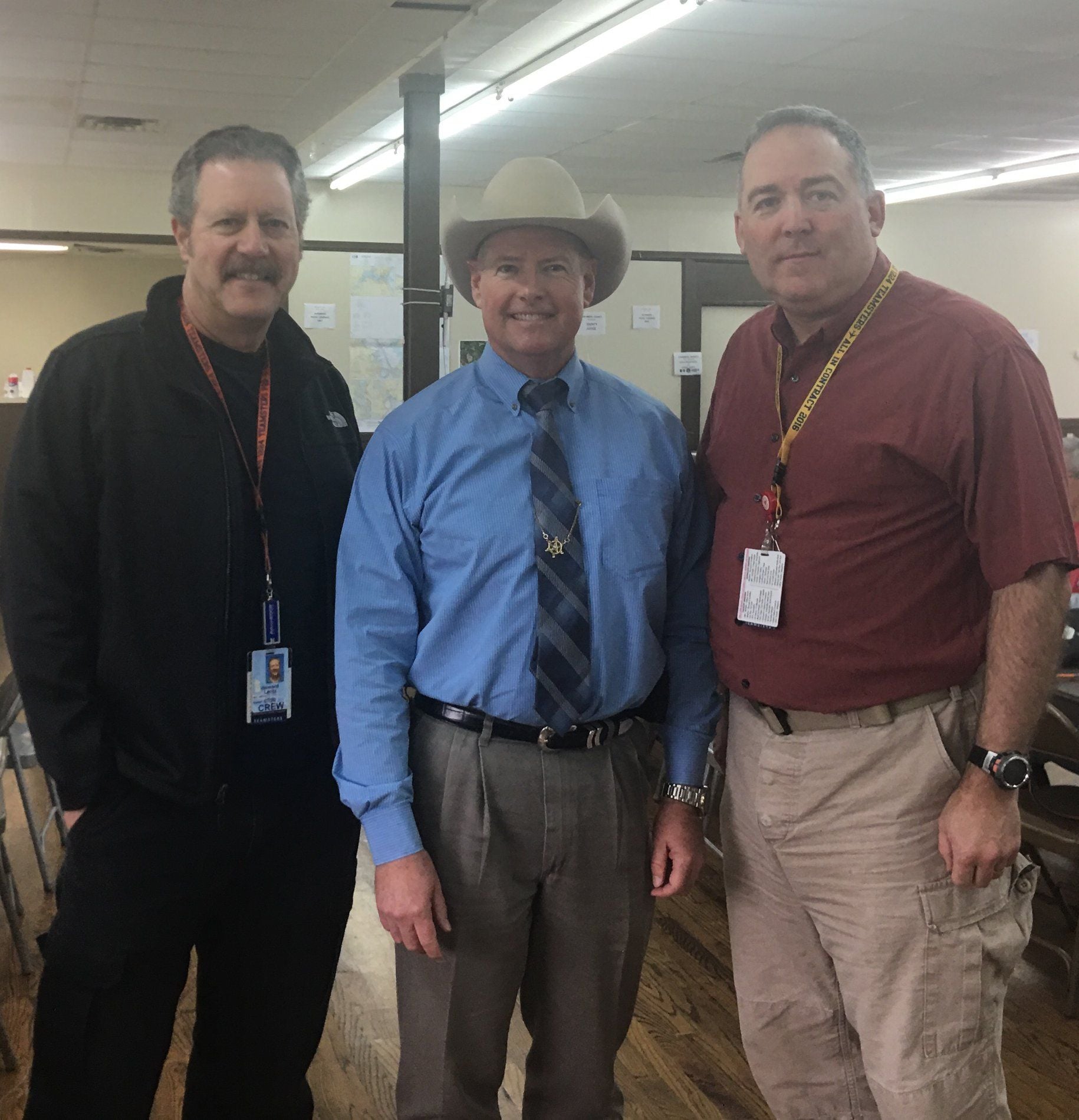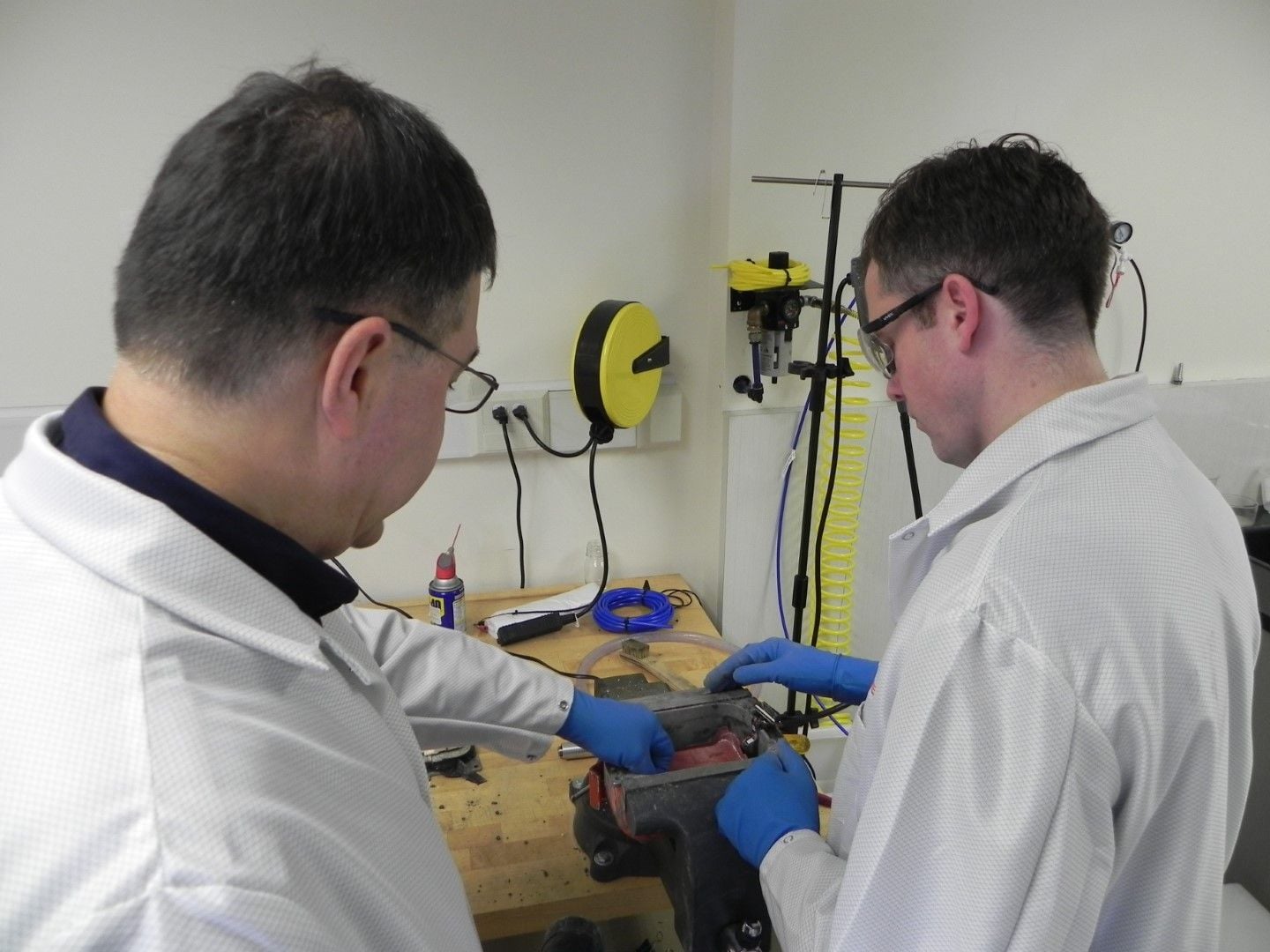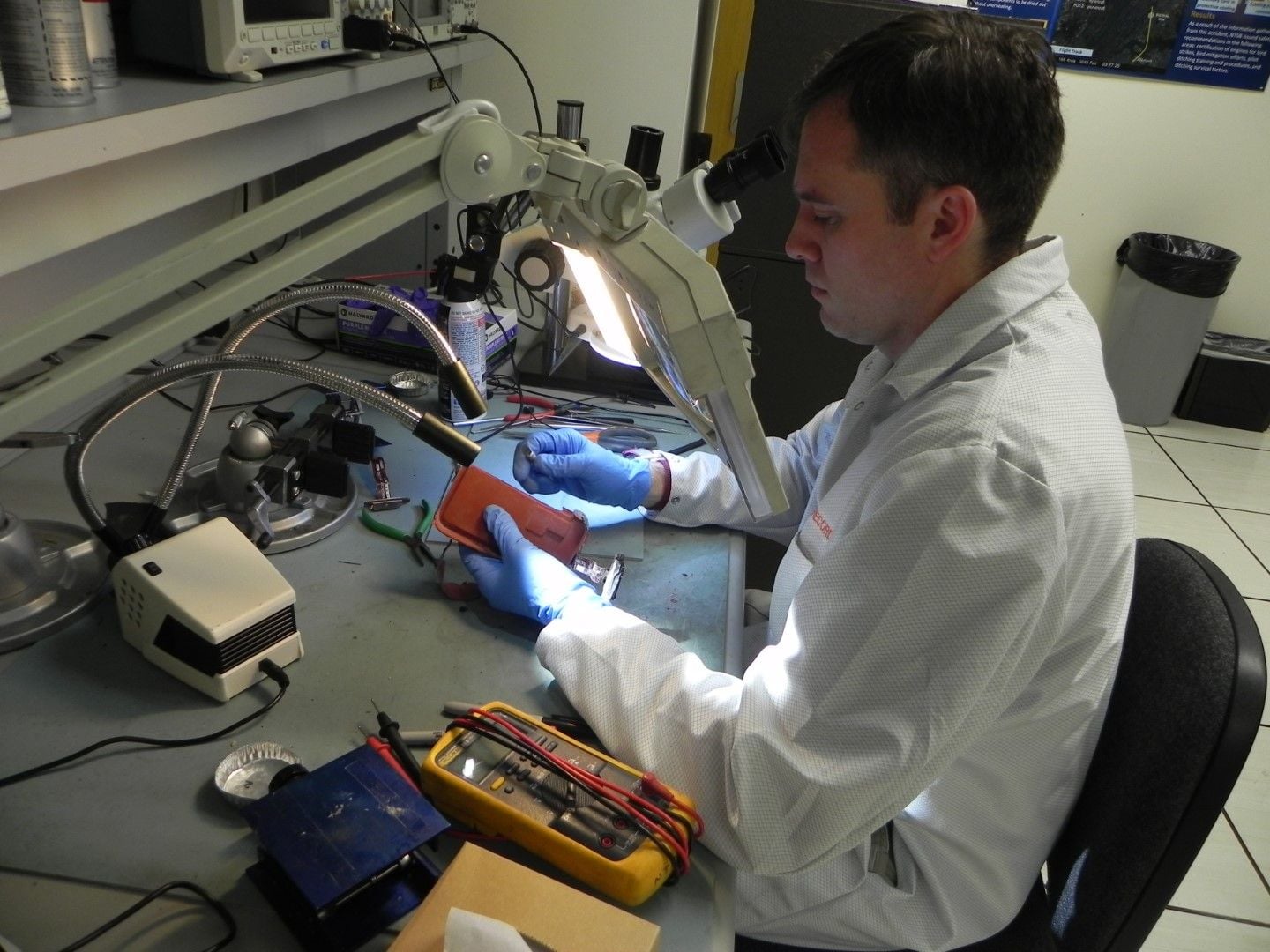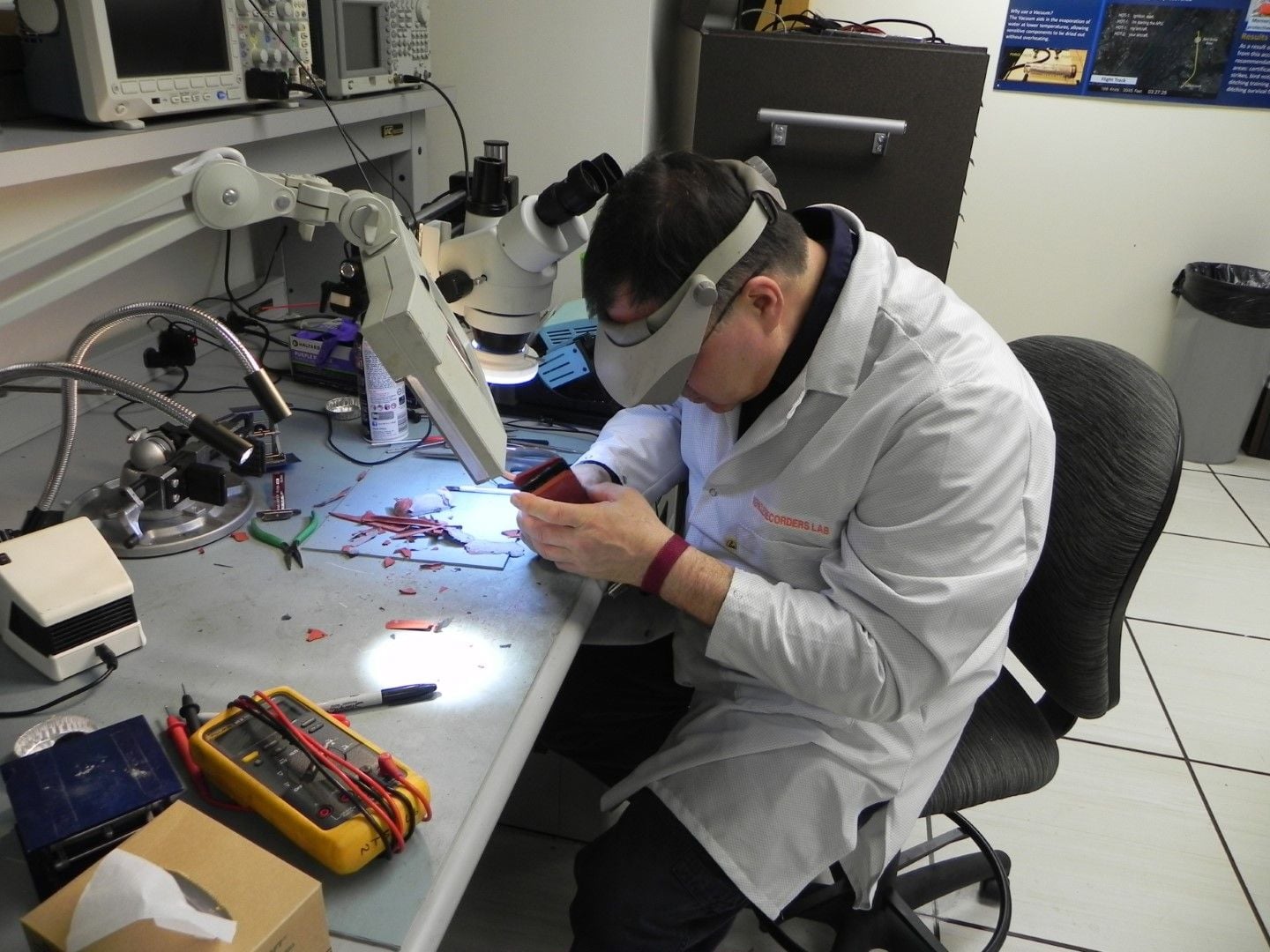Atlas Air 767 down/Texas
Does the pinger keep on ticking after they retrieve the CVR, maybe that's why the remove it to save their ears when they pack it in water
Join Date: Jul 2009
Location: Not far from a big Lake
Age: 81
Posts: 1,454
Likes: 0
Received 0 Likes
on
0 Posts
If they show the end of the unit that had the pinger attached, you can look to see if the sheared off tips of the bolts are still there.
Considering the relatively high pinger frequency, I doubt that people in the vicinity will find it very disturbing, particularly if they have been around jet engines any amount of time.
Considering the relatively high pinger frequency, I doubt that people in the vicinity will find it very disturbing, particularly if they have been around jet engines any amount of time.
Join Date: Jun 2001
Location: Rockytop, Tennessee, USA
Posts: 5,898
Likes: 0
Received 1 Like
on
1 Post
From the NTSB FDR Handbook:
3.5. If there is any visible damage to the underwater locator beacon (ULB or “pinger”), it should be removed prior to shipping. Use caution when handling damaged beacons.
Join Date: Sep 2001
Location: Connecticut, USA
Age: 64
Posts: 252
Likes: 0
Received 0 Likes
on
0 Posts
Join Date: Aug 2002
Location: Zone of Alienation
Age: 79
Posts: 9
Likes: 0
Received 0 Likes
on
0 Posts
Last edited by FIRESYSOK; 3rd Mar 2019 at 20:39.
Join Date: Jun 2001
Location: Rockytop, Tennessee, USA
Posts: 5,898
Likes: 0
Received 1 Like
on
1 Post
The NTSB is urging the FAA to require 25-hour CVR recorders after incidents like the one with Air Canada at SFO in 2017 where pertinent CVR data was overwritten.
https://www.ntsb.gov/investigations/...ts/ASR1804.pdf
The National Transportation Safety Board (NTSB) is providing the following information to urge the Federal Aviation Administration (FAA) to take action on the safety recommendations issued in this report. These recommendations address the need to install cockpit voice recorders (CVR) with a minimum 25-hour recording capability on all newly manufactured airplanes required to have a CVR and retrofit these CVRs on existing aircraft required to have flight recorders. These recommendations are derived from the NTSB’s experiences with investigations that lacked access to relevant CVR data. Information supporting these recommendations is discussed below.
Join Date: Feb 2004
Location: Australia
Posts: 1,307
Likes: 0
Received 0 Likes
on
0 Posts
Join Date: Jan 2008
Location: Hawaii
Posts: 8
Likes: 0
Received 0 Likes
on
0 Posts
Here's a picture of an undamaged one that looks more similar to what was recovered - photovault.com/data/comps/IAC/IACV01P05_17.jpg
...
low frequencies will travel further, however they take more energy to develop than the higher frequencies. Low frequencies are also in the main background frequencies of the ocean, below the snapping shrimp and whale song freqs. Shipping noise has primary frequencies in the very low levels, with blade rates and shaft rates that are down in the bottom of the spectrum, (still audible to human ears though), but they have harmonics above that which can be strong, particularly when a multiple of the number of blades.Higher frequencies will attenuate faster than the lower frequencies, but they are also usually easier to analyse with fewer artifacts from the sampling rate that is used for the transform.
Join Date: Jun 2001
Location: Rockytop, Tennessee, USA
Posts: 5,898
Likes: 0
Received 1 Like
on
1 Post
Sheriff Hawthorne respects the professional relationship that Captain John Jester IBT Teamsters (Pilots Union) Chief Accident Investigator from Hoofddorp, Netherlands and Captain Howard Lentz Accident Investigator from Cameron Park, CA, have with the National Transportation Safety Board. The Sheriff has reached out to these gentlemen for expert advice regarding equipment and systems of the aircraft which has been instrumental in assisting the Chambers County Sheriff’s Office with our role and responsibilities in the recovery of flight 3591.

The Teamsters have an unfortunate long history of close ties to what is euphemistically called 'The Mob'. I believe James Hoffa, the current IBT president, is the first head of the Teamsters since 1952 not to be indicted on felony federal charges. Not all of the predecessors went to prison, Jimmy Hoffa (James' father) disappeared, Jackie Presser died of a heart attack before reporting to Club Fed and Ron Carey was acquitted.
Join Date: Jun 2001
Location: Rockytop, Tennessee, USA
Posts: 5,898
Likes: 0
Received 1 Like
on
1 Post
Update on the CVR and FDR analysis from the NTSB:

NTSB Laboratory Completes Initial Review of Cockpit Voice Recorder, Recovers Flight Data Recorder
3/5/2019
Three people (the two pilots for the flight and a non-revenue jump-seat pilot) died when Atlas Air Flight 3591, a Boeing 767-300 cargo jet, crashed in the muddy marshland of Trinity Bay Feb. 23, 2019, about 40 miles from Houston’s George Bush Intercontinental Airport. The airplane was destroyed. The airplane was carrying cargo for Amazon.com Inc., and the US Postal Service from Miami to Houston.The condition of the accident site made locating the recorders challenging. Directors from the Office of Research and Engineering and the Office of Aviation Safety conducted an audition of the CVR as part of the NTSB’s ongoing investigation of the accident. The audition revealed the following information, which is preliminary and subject to change as the investigation continues:
The recording included the final portion of the flight; however, the quality of the audio is poor.
There are times during the recording when the content of crew discussion is difficult to determine, at other times the content can be determined using advanced audio filtering.
The crew was in communication with air traffic control and were being provided radar vectors for the runway 26L approach into George Bush Intercontinental Airport.
Crew communications consistent with a loss control of the aircraft began approximately 18 seconds prior to the end of the recording.
The flight data recorder arrived at the NTSB’s Recorder Lab Sunday at 11:45 p.m. The memory module was disassembled, cleaned and dried, and download of the data was achieved Monday afternoon. Initial review of the data revealed:
NTSB recorder investigators are currently verifying and validating the FDR data, and the NTSB plans to provide a summary in an investigative update in a few days. Technical experts in the CVR group will convene in the coming week to review the entire recording and produce a transcript of the accident recording. It will be a time-consuming process to complete the transcript. The CVR group is one of the seven investigative groups established by the Investigator-in-Charge for the accident investigation.
Engineers at the National Transportation Safety Board’s Office of Research and Engineering Vehicle Recorder Division completed the initial review of the Atlas Air Flight 3591 cockpit voice recorder Saturday evening and recovered the airplane’s flight data recorder Sunday.
Three people (the two pilots for the flight and a non-revenue jump-seat pilot) died when Atlas Air Flight 3591, a Boeing 767-300 cargo jet, crashed in the muddy marshland of Trinity Bay Feb. 23, 2019, about 40 miles from Houston’s George Bush Intercontinental Airport. The airplane was destroyed. The airplane was carrying cargo for Amazon.com Inc., and the US Postal Service from Miami to Houston.The condition of the accident site made locating the recorders challenging. Directors from the Office of Research and Engineering and the Office of Aviation Safety conducted an audition of the CVR as part of the NTSB’s ongoing investigation of the accident. The audition revealed the following information, which is preliminary and subject to change as the investigation continues:
The length of the recording is approximately two hours and was obtained from a download of a solid-state type cockpit voice recorder.
The recording included the final portion of the flight; however, the quality of the audio is poor.
There are times during the recording when the content of crew discussion is difficult to determine, at other times the content can be determined using advanced audio filtering.
The crew was in communication with air traffic control and were being provided radar vectors for the runway 26L approach into George Bush Intercontinental Airport.
Crew communications consistent with a loss control of the aircraft began approximately 18 seconds prior to the end of the recording.
The flight data recorder arrived at the NTSB’s Recorder Lab Sunday at 11:45 p.m. The memory module was disassembled, cleaned and dried, and download of the data was achieved Monday afternoon. Initial review of the data revealed:
The accident flight was captured, and the FDR contained a total of about 54 hours of data from 17 flights.There were approximately 350 parameters recorded by the FDR detailing the motion of the aircraft and operation of its engines, flight controls and other systems.
NTSB recorder investigators are currently verifying and validating the FDR data, and the NTSB plans to provide a summary in an investigative update in a few days. Technical experts in the CVR group will convene in the coming week to review the entire recording and produce a transcript of the accident recording. It will be a time-consuming process to complete the transcript. The CVR group is one of the seven investigative groups established by the Investigator-in-Charge for the accident investigation.
In this photo, taken Saturday in the NTSB laboratory in Washington, an NTSB engineer from the Office of Research and Engineering’s Vehicle Recorder Division inspects memory boards from the cockpit voice recorder of Atlas Air Flight 3591 for signs of damage and water intrusion. Atlas Air Flight 3591 crashed Feb. 23, 2019, about 40 miles from Houston’s George Bush Intercontinental Airport, and the NTSB recovered the airplane’s CVR March 1, 2019. NTSB photo.

Join Date: Mar 2019
Location: San Antonio
Posts: 2
Likes: 0
Received 0 Likes
on
0 Posts
jackscrew obsevations
@ FDR Thanks for your response.
Here is the "proposed AD
" ....in 2000"On January 31, 2000, there was an accident involving a McDonnell Douglas Model DC-9-83 (MD-83) airplane. The National Transportation Safety Board (NTSB) determined that the probable cause of this accident was a loss of airplane pitch control resulting from the in-flight failure of the acme nut threads of the jackscrew assembly of the horizontal stabilizer trim system.
The NTSB concluded that the thread failure was caused by excessive wear, resulting from insufficient lubrication of the jackscrew assembly.Start Printed Page 58621The drive mechanism of the horizontal stabilizer on McDonnell Douglas Model DC-9-83 (MD-83) airplanes has a jackscrew assembly with an acme screw.
The drive mechanism of the horizontal stabilizer on Boeing Model 767 airplanes uses a ballscrew. Acme screws and ballscrews have some differences in design, but perform similar functions and have the same airplane level effect following failure. The manufacturer's safety analysis of the 767 drive mechanism found no safety problems with the configuration of the drive mechanism, but showed that changes to the maintenance procedures and maintenance intervals are required to keep the drive mechanism properly maintained and operating as designed.
We have received a report indicating that the ballscrew in the drive mechanism of the horizontal stabilizer on a Boeing Model 757 series airplane showed extensive corrosion, which could lead to excessive wear. The ballscrew on Boeing Model 757 airplanes is similar to that on Boeing Model 767 airplanes that are the subject of this proposed AD. Therefore, both of these airplane models could have the same unsafe condition.
We are considering separate action for the Boeing Model 757 series airplanes and other similar Boeing airplanes.Extensive corrosion of the ballscrew in the drive mechanism of the horizontal stabilizer, if not corrected, could cause an undetected failure of the primary load path for the ballscrew and subsequent wear and failure of the secondary load path, which could lead to loss of control of the horizontal stabilizer and consequent loss of control of the airplane."
Here is the "proposed AD
" ....in 2000"On January 31, 2000, there was an accident involving a McDonnell Douglas Model DC-9-83 (MD-83) airplane. The National Transportation Safety Board (NTSB) determined that the probable cause of this accident was a loss of airplane pitch control resulting from the in-flight failure of the acme nut threads of the jackscrew assembly of the horizontal stabilizer trim system.
The NTSB concluded that the thread failure was caused by excessive wear, resulting from insufficient lubrication of the jackscrew assembly.Start Printed Page 58621The drive mechanism of the horizontal stabilizer on McDonnell Douglas Model DC-9-83 (MD-83) airplanes has a jackscrew assembly with an acme screw.
The drive mechanism of the horizontal stabilizer on Boeing Model 767 airplanes uses a ballscrew. Acme screws and ballscrews have some differences in design, but perform similar functions and have the same airplane level effect following failure. The manufacturer's safety analysis of the 767 drive mechanism found no safety problems with the configuration of the drive mechanism, but showed that changes to the maintenance procedures and maintenance intervals are required to keep the drive mechanism properly maintained and operating as designed.
We have received a report indicating that the ballscrew in the drive mechanism of the horizontal stabilizer on a Boeing Model 757 series airplane showed extensive corrosion, which could lead to excessive wear. The ballscrew on Boeing Model 757 airplanes is similar to that on Boeing Model 767 airplanes that are the subject of this proposed AD. Therefore, both of these airplane models could have the same unsafe condition.
We are considering separate action for the Boeing Model 757 series airplanes and other similar Boeing airplanes.Extensive corrosion of the ballscrew in the drive mechanism of the horizontal stabilizer, if not corrected, could cause an undetected failure of the primary load path for the ballscrew and subsequent wear and failure of the secondary load path, which could lead to loss of control of the horizontal stabilizer and consequent loss of control of the airplane."
Join Date: Dec 2014
Location: United States
Posts: 105
Likes: 0
Received 0 Likes
on
0 Posts
Crew communications consistent with a loss control of the aircraft began approximately 18 seconds prior to the end of the recording.
Join Date: Nov 1999
Location: Mk. 1 desk at present...
Posts: 365
Likes: 0
Received 0 Likes
on
0 Posts
That is an extremely neutral form of words from the NTSB, as it should be at this stage; it simply confirms that the crew were conscious and had situational awareness. I wouldn't read any more into it than that.
Longtimelurker
Join Date: Nov 1998
Location: killington Vt
Posts: 391
Likes: 0
Received 0 Likes
on
0 Posts
An ultimate loss of control may not disprove the speculation about a deliberate act, but "crew communications consistent with a loss of control" seems to come pretty close.






